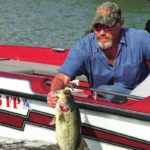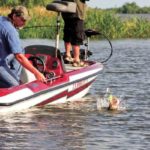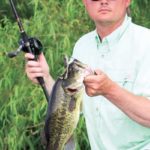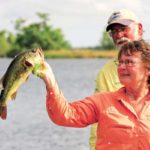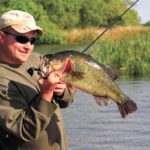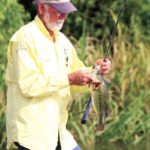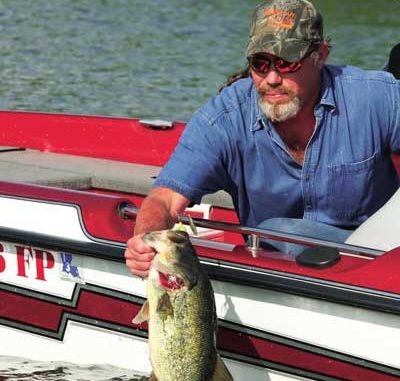
These successful marsh bass anglers say there’s only one place where the action will be on fire this month.
Marsh bass have a rough life. Unlike their fat kin that bide their time lazily lounging under logs in lakes, marsh bass spend their days battling tidal current, searching for something to eat and evading schools of roaming redfish.
Because of their having to survive in such an extreme habitat, marsh bass sometimes behave like speckled trout. They stack up on points. They school in tight groups. And they bite fast.
That makes them fun to catch.
However, marsh bass frequently get overlooked in favor of speckled trout and even redfish as anglers drive right past them to get to the saltwater species.
Unfortunately, many saltwater hotspots in South Louisiana are now closed to fishing because of the oil leak in the Gulf of Mexico. That means anglers are scrambling to find new areas to fish this summer as they look to fill the void in their lives that only a fish tugging at the end of a line can fill.
Where there is a will, there is a way, and nowhere is the will to fish stronger than in Louisiana. Thankfully, Sportsman’s Paradise offers many kinds of fish to catch and many ways to catch those fish.
Maybe marsh bass are your answer.
And the next best thing about marsh bass other than they bite just as fast as speckled trout once you find them is that they aren’t very far away. In fact, marsh bass can be found simply by heading a little farther north in the same areas where you fish saltwater species.
Being that there will be more anglers looking to catch some green trout this summer than ever before, I went straight to the anglers who know the fish best to find out how they catch marsh bass during July and August.
The anglers who compete in the Louisiana South Teams division of Media Bass have to catch marsh bass if they hope to win tournaments, earn the Angler of the Year title or advance to championship events.
Although they could all pass along some timely tips, three of the two-angler teams rose above the rest because of various accomplishments throughout the last few years.
Chris Babin from Raceland and Chris Carlos from Lockport recently dominated the Des Allemands event with a 25-pound five-fish limit.
David Cavell from Prairieville and Corey Wheat from Gonzales currently command the lead in the Anglers of the Year race.
And the husband-and-wife team of James and Sharlot Edwards has spent 30 years fishing together for marsh bass.
As I pulled each one aside, I expected him or her to share a secret or two with me that would help anglers adjust to catching marsh bass rather than speckled trout or redfish.
However, as our discussions unfolded, I learned that there aren’t many secrets to catching marsh bass during the summer.
This is one secret. And it just so happens that each angler shared it without knowledge that the others were sharing the same thing.
The secret is to find a combination of shade and moving water. Since this is marsh fishing, however, most of the shade is provided by grass beds.
Each team looks for this shade just a little bit differently.
Babin and Carlos
Babin says he searches for hydrilla over all other kinds of grass. His most productive hydrilla mats are those that grow on top of a shallow flat with edges that drop off into deeper water. Deeper is somewhat relative in the marsh, though, so a 2-foot grass flat that drops off into 4 feet of water is a good drop.
“Take Cataouatche for an example of why I like hydrilla,” Babin began. “During the early summer before it mats out, you can troll through the grass and cast just about everywhere. But once that mat forms, you’re going to have to move to the edges or plow into the middle.”
When the grass mats out, Babin and Carlos like to get on the edge of the drop and fish with fast-moving topwaters like buzz baits and frogs first thing in the morning, but they switch to spinnerbaits later in the day.
“We like to say the fish don’t bite around the grass until 10 a.m.,” Babin said. “So if you don’t catch anything before then, you don’t have much to worry about. I think they relate to the grass a little better after the sun gets up because they’re looking for shade from that bright light.”
Babin added that the reason bass relate to grass in the marsh is the same reason they relate to it in a sprawling reservoir like Toledo Bend. Other than shade, it’s all about food. Grass in the marsh attracts all kinds of shrimp, crabs, crawfish and little minnows.
“If you’re by yourself, put your boat right up there on the edge of the grass and make parallel casts to the grass,” Babin said. “But if you’ve got your partner with you, you’re going to have to kind of fish it at a 45-degree angle so both of you can reach the grass.”
Cavell and Wheat
“We focus a lot on moving water and shade,” said Cavell. “Shade could be from anything — a willow tree, cypress trees — but grass mats or lilies are what we usually fish. And it’s usually a combination of both.”
Cavell and Wheat like fishing with soft plastics rigged Texas style with big, heavy weights so they can punch their baits through the heaviest parts of the mats where the really big bass live.
“You can catch a lot of smaller bass on the edge of the shade,” Cavell said, “but you’ve got to get into the thick stuff to catch the bigger bass. It seems like the bigger bass don’t want anything to do with the smaller fish, so the big ones will get under the mat by themselves.”
Wheat added that the team also likes to fish patches of water hyacinths where the wind has blown them against a bank or into a point. He prefers hyacinths matted up in 2 to 3 feet of water, and he uses the same heavy weights and soft plastics as the team uses in the grass mats.
“You’ve got to let the fish tell you how to fish your bait,” Wheat said. “If it’s deeper water, sometimes they’ll suspend right under the mat, so you might have to shake a few times to get them to bite. But most of the shallow stuff we fish, they eat it as soon as it falls.”
Cavell and Wheat have found that marsh bass under the mats are suckers for Sweet Beavers and Speed Craws. Both are rigged on heavy-duty 5/0 hooks tied to 65-pound-test braided line. They start with at least a 1-ounce weight and go heavier based on the wind and thickness of the mats.
James and Sharlot Edwards
Like the other two successful teams, James and Sharlot Edwards look for the same combination of moving water and shady grass beds. They indicated that, although bass will bite on any moving tide, they bite best around the grass when the tide is going out.
“The bass just don’t feed as well when the tide is coming in,” said James Edwards. “The bait moves closer to the bank, and the fish move tight to cover. High tide can also put too much water over the top of grass beds for you to find them. But if you know where some grass is, you can fish on top of it when the tide comes in.”
Team Edwards likes to look for the darkest spots they can find within the grass beds, and they say bass always position on the downcurrent side of the grass beds with their noses pointed into the current.
“The grass will lay over and make a dark spot at the bottom of the grass,” Sharlot Edwards added. “That’s the spot we try to fish. And even though bass push into the grass during the day, we find vegetation to be most productive very early in the morning and late in the evening.”
The husband and wife have had a lot of success throwing Chatter Baits over the top of the grass and then reeling them back with the current. They crawl these baits over the grass and allow them to fall directly into the dark spots on the downcurrent side of the grass. Bass eat the Chatter Bait as it falls to the bottom.
“You can also do the same thing with a spinnerbait,” James Edwards said. “But I won a Media Bass individual tournament last year fishing that Chatter Bait around the grass in Cataouatche, so I’m kind of hooked on that bait.”
And anybody who heads to the marsh to find some grass beds with moving water around them is going to get a good taste of fishing these green trout.
Don’t let the term marsh bass fool you, either. You may think they’re all small, but these tournament teams regularly bring in 3-, 4- and 5-pound bass from the marsh.
If you’ve got the will, marsh bass will provide the way because the action is hot in the shade.
